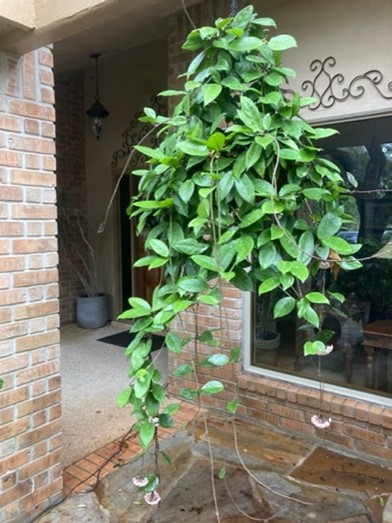By Kathy MacNaughton, Bexar County Master Gardener Intern
January 2024

My sister and I share a love of beautiful, flowering plants and our visits often include the exchange of cuttings. A couple of years ago, while touring her lovely Atlanta, Georgia landscape, she introduced me to a green, waxy-leaved vine just off her patio. Commonly known as a wax plant or porcelain flower, or scientifically, Hoya carnosa, it displayed the most fascinating parachute-like clusters of pale pink, star-shaped flowers.

I was intrigued and came home with a few cuttings that my gardener husband faithfully planted in a hanging basket. In the midst of his over 150 potted plants, I quite easily forgot about it until this fall when it bloomed. Owning this plant is an exercise in patience, as it is slow-growing. Some Hoyas can bloom in a few years while others need as much as five to seven years, but the reward is worth the wait! Faithful and resilient, this vine can grant you 30+ years of enjoyment with minimal care.
Typically a house plant, both my sister and I grow ours outdoors in bright, indirect light with partial shade, bringing them in when the temperature drops below 50 degrees or less. Another reason we prefer an outdoor environment… hummingbirds relish the flowers’ dripping nectar which can be a mess; a fair exchange for a delightful fragrance strongest in the evening.
Plants in my care need to be beautiful AND minimal maintenance! Hoyas fit those requirements.

- Very little pruning. Pruning is best done in early spring before its most rapid growth begins. It flowers from the spurs. New flowers form on the stem year after year on the same spurs so do not remove leafless stems. Feed regularly with a fertilizer suitable for epiphytic plants.
- Low watering needs. Your Hoya likes to dry out almost completely between waterings. If you water too often, or the soil isn’t well-drained, it most likely won’t bloom and you run the risk of root rot.
- Leave it alone. Do not move or repot when the plant is budding or flowering.
- Little need to re-pot. Hoyas prefer to be fairly root-bound and this encourages blooming. Only repot when the roots begin to emerge from the drainage holes and even then, just in a slightly larger pot.
- Easy propagation. We all love to share our plant babies with friends (and strangers). Stem cuttings in water are recommended. When long roots appear, put them into a pot with well-drained soil. The cuttings from these plants aren’t true Hoya “babies” because cuttings are actually a clone from the mother plant; albeit smaller, they are the same age as the mother, which speeds up the blooming timeline.
All photos by Author
